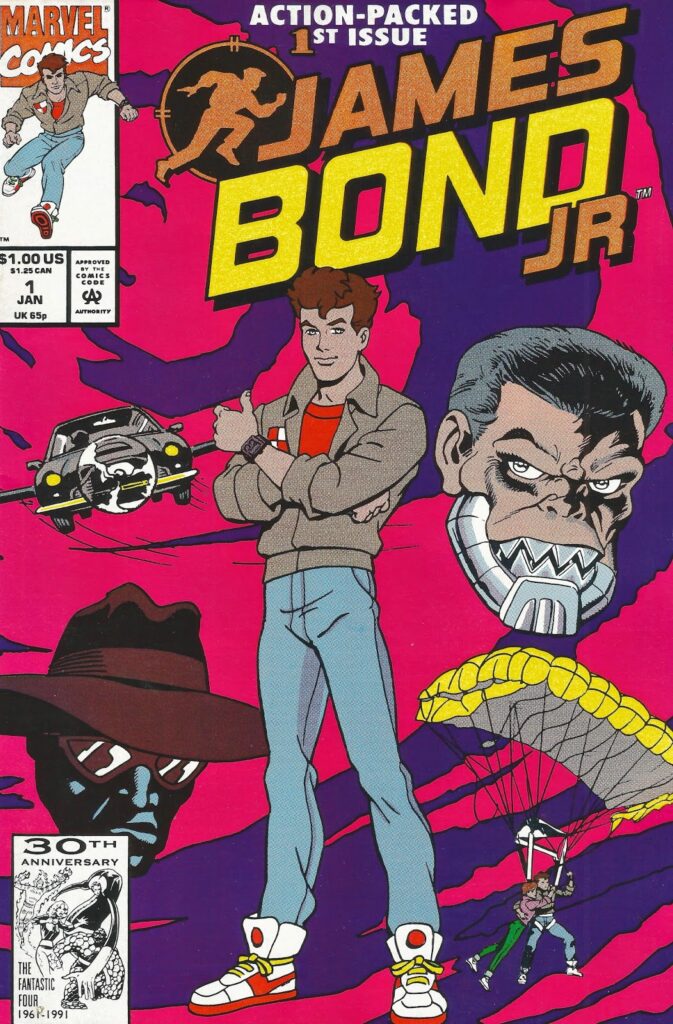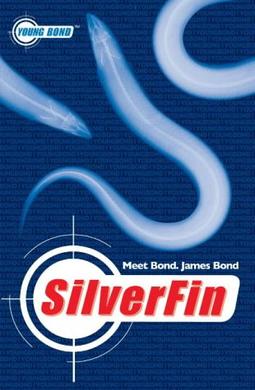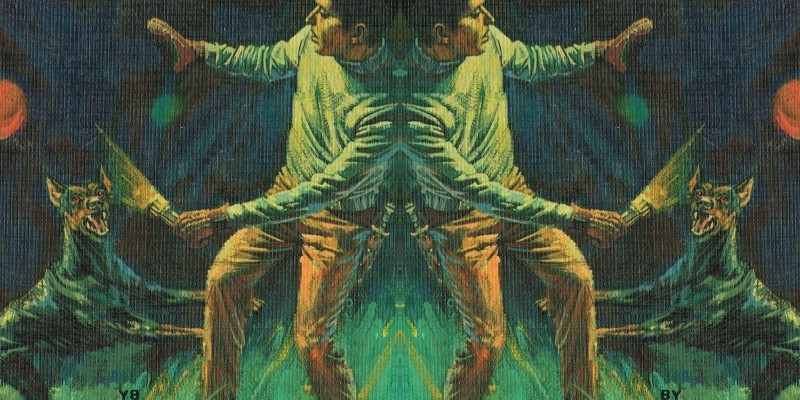When you think of the British agent with a license to kill, seducing his way around the world, keeping the rest of us safe, you likely don’t think of children. This is probably a good thing since the source novels are most definitely of their era, rife with casual sexism, racism, misogyny, homophobia and rape. While the films do a little better in some of these areas, they’re not exactly blameless.
It’s for these reasons that perhaps the idea of a teenage Bond isn’t something that instantly springs to mind as a great idea. Yet, as you’ll see, it’s been a long sought after market that the keepers of the Bond legacy have repeatedly tried to reach, with varying degrees of success.
When Ian Fleming suffered a heart attack and died in the summer of 1964, it caught a lot of people by surprise. (Well, as much as you can be surprised when someone who once smoked 80 cigarettes a day turns out not to be the healthiest person you’ve ever met.) He had just turned in the manuscript for The Man With the Golden Gun, which would be published only 8 months later. The book sold well, but Fleming’s death meant he had only worked on a first draft. His usual method was to add the details that he was well-known for in his second draft, so, the book when published was criticized for not feeling enough like his earlier work.
Well-known author Kingsley Amis was the first person to write a Bond story after Fleming’s passing – he was a close friend and the year after Fleming’s death, had contributed two books to the Bond canon, The James Bond Dossier and The Book of Bond. When the Fleming estate wanted an author to continue Bond’s adventures a few years later, they turned to Amis. Colonel Sun was published in 1968. However, that was the adult adventures of 007.
In 1967, a year earlier, Jonathan Cape Publishing (publishers of Fleming’s books) and Gildrose Productions (a production company Fleming had owned) released the first Bond spin-off… and it was unique. The Adventures of James Bond Junior 003 ½ is an interesting choice to be the first book post-Fleming.
However, this story wasn’t about James Bond’s son – it was about his nephew, somehow also named James Bond. Already from this early date, the Bond story gets muddled. Per Fleming, Bond was an only child and an orphan. No word on how David Bond (James’ supposed brother in this tale) wasn’t mentioned previously. The book was authored by a pseudonymous RD Mascott. Decades of fan debate offered takes on the actual author with both Roald Dahl (who wrote the screenplay for You Only Live Twice) and Amis considered and then discarded. It was only after his passing that the family of Arthur Calder-Marshall was acknowledged as the true author.
The reception for the book was surprisingly strong, with The Observer saying, “the story is a small perfect triumph in the hands of a master.” The Library Journal described it as, “a notch above what might be expected.”
Several Bond books followed in the subsequent decade, including Amis’ Colonel Sun, and two novelizations of screenplays that strayed far from Fleming’s original work. It was in the early 80s that John Gardner was announced as the official new Bond author.
With the release of A View to a Kill in 1985, Gildrose and EON Productions again aimed for a junior market. However, they kept Bond as a grown-up, just re-working the stories for a younger audience.

Thus there was the release of The James Bond Storybook of the Movie A View to A Kill. The book was a pretty faithful telling of the film’s plot, though leaving out more of the salacious details. In the opening scene, Bond produces a bottle of vodka and a tin of caviar and tells Kimberly Jones, “a beautiful and young agent,” that it’s time “for a celebration.” The scene then ends, so for all the reader knows they could have started singing Happy Birthday. Likewise the final scene in the book, where Q’s robot Snooper finds Bond in the shower, the author fails to mention that James isn’t washing his back alone. (Though, they are able to fit in the ‘just cleaning up a few details’ pun, thankfully.)
There was also a series of four storybooks, accompanied by a cassette featuring the story being read to you and sound effects. (And yes, one of the sound effects was the sound so you would know when to turn the page.) They do away with the women all together here, so the story of Moonraker spares all of us the wondering of how Dr Holly Goodhead got her name. That said, the violence isn’t really toned down, so people are hit in the chest with blow darts and then shot out into space. (Again, the puns remain.) The films turned into storybooks were Dr No, The Spy Who Loved Me, Moonraker and A View to a Kill, each one focusing on one sequence in the final film.
Around the same time, with the Choose Your Own Adventure books popular among kids, there was a rival series titled Find Your Fate. The books featured a series of different characters, with the majority of the books devoted to Indiana Jones, but Bond got four books of his own. Each book used something from the A View to a Kill screenplay as a jumping off point and, with his wife editing the series, YA horror legend R.L. Stine even wrote one of the books, Win, Place or Die.
It seems like an odd time in the Bond franchise to go all-in on the actor playing Bond (the character on the storybook tapes has a definite Roger Moore affect to his speech and the Find Your Fate series uses Moore’s likeness on the cover), seeing as A View to a Kill was the last Bond film featuring Moore and it is often derided by both fans and critics alike for its frequent use of stunt-doubles lest the 57 year-old Moore get injured. In 1987, a follow-up storybook for children, complete with accompanying audio cassette, told the tale of Timothy Dalton’s Bond debut The Living Daylights. It’s a little better than the Moore-era tapes, but it’s still strange to hear actors discuss international relations with the KGB in a story clearly aimed at pre-teen market.
However, shortly after the release of License to Kill in 1989, the Bond franchise pretty much went into mothballs as EON Productions got into a legal squabble with MGM over an undervaluation of the Bond film library. It was a dispute that led to Dalton leaving the franchise, additional films planned then scrapped and keeping Bond off movie screens for almost 6 years.
With all of this as a backdrop, and as a way to continue a Bond presence in the public eye, screenwriter, and eventual producer Michael G Wilson (and step-son to Albert Broccoli, the producer responsible for every Bond project to that point, save Never Say Never Again) co-created an animated series bringing back James Bond Junior.
Was this Bond supposed to be James’ son? Nope, still his nephew, making the ‘Jr’ designation still confusing. The series placed Bond as a student at Warfield Academy, with his best friends IQ (grandson of Bond’s gadget master Q), Tracy Milbanks (her first name being a nod to Bond’s late wife), and Gordo Leiter, son of Bond friend Felix Leiter.
The show was very similar to other afternoon cartoons of the day, with accompanying quality, or lack thereof. Some of the film characters were acknowledged, mostly in the role of villain, including metal-mouthed Jaws and diminutive side-kick Knick-Knack. Goldfinger himself made an appearance, apparently feeling much better after being sucked out of a plane at the end of the film (…oh… sorry, spoiler alert), but here he has a daughter, named Goldie. Other brand new villains included Scumlord, Ms Fortune, and a pirate-themed villain titled… wait for it… Walker D. Plank.

65 episodes were produced, which amounted to one full season. The show didn’t last past that first season, but there were additional marketing opportunities. A tie-in boardgame was released along with 6 books based on episodes. 1993 saw four of those books adapted for younger audiences, who thankfully were spared from Walker D. Plank. Marvel Comics released 12 issues of a comic book, with only the first 5 issues featuring stories from the TV show.
There were, of course, tie-in toys and eventual VHS releases of the show, but, the franchise and EON have tried to downplay the existence of this show, so hopes for a live-action version of Mr Plank are pretty much dashed. After this whole production, EON has also seemingly stepped out of the Young Bond game, with no word of additional versions forthcoming.
With Pierce Brosnan taking the title mantle starting with Goldeneye, the franchise was back on stable grounds and on movie screens around the world. But it wasn’t until 2005 that another swing was taken at the young Bond concept.
April of that year saw the release of SilverFin. The book was written by British author and actor Charlie Higson, who was best known as a comic actor and writer from numerous BBC programs. While fans were anxious, Ian Fleming Publications (the new name for Gildrose) were happy with what they saw and Higson ended up writing four young Bond books. IFP had recently been acquired by Fleming’s estate and they were eager to remind people that Bond started in the literary form and worked well in that format too.
Granted, anticipation wasn’t high; still smarting from the TV series, fans had their doubts, to say the least. Yet, when they actually got their hands on the book, a lot of them changed their tune. (And yes, I include myself in this later group.)

What was different from all the previous takes? Well, for starters, they were plotted and written for their audience and the character wasn’t forced into a Fleming world. They also steered clear of many of the Bond film tropes, creating a fully-rounded character. Higson said in interviews that his marching orders were that the teenage Bond needed to fit with Fleming’s original timeline, he should be attending Eton, have an important teacher in his life whose last name started with an ‘M’ and, perhaps most importantly, Bond should not be a teenage spy.
These were adventures first and foremost. And if response to SilverFin was strong, the follow-up book, Blood Fever hit #1 in the UK for eleven weeks. This second book even worked to undo some of the problems with Fleming, including having James meet and spend time with a gay Uncle and his partner. It was certainly a step in the right direction.
Higson stepped down after delivering five books in four years. The mantle was then handed to writer Steve Cole. Having worked on Doctor Who’s audio dramas and on the worldwide merchandizing to the revitalized series, Cole was a good fit for the series and produced three more Young Bond adventures.
So, where to now? IFP has announced a new continuation novel of the adult Bond, with Anthony Horowitz handling the writing for his third Bond effort, which will be out in May. Meanwhile, Kim Sherwood is handling a new series, based on the Double O Section, telling tales of Bond’s co-workers, and not necessarily including the popular spy. It is only a matter of time before yet again, a teenage boy will look up, and introduce himself, “Bond. James Bond…. Junior.”

















